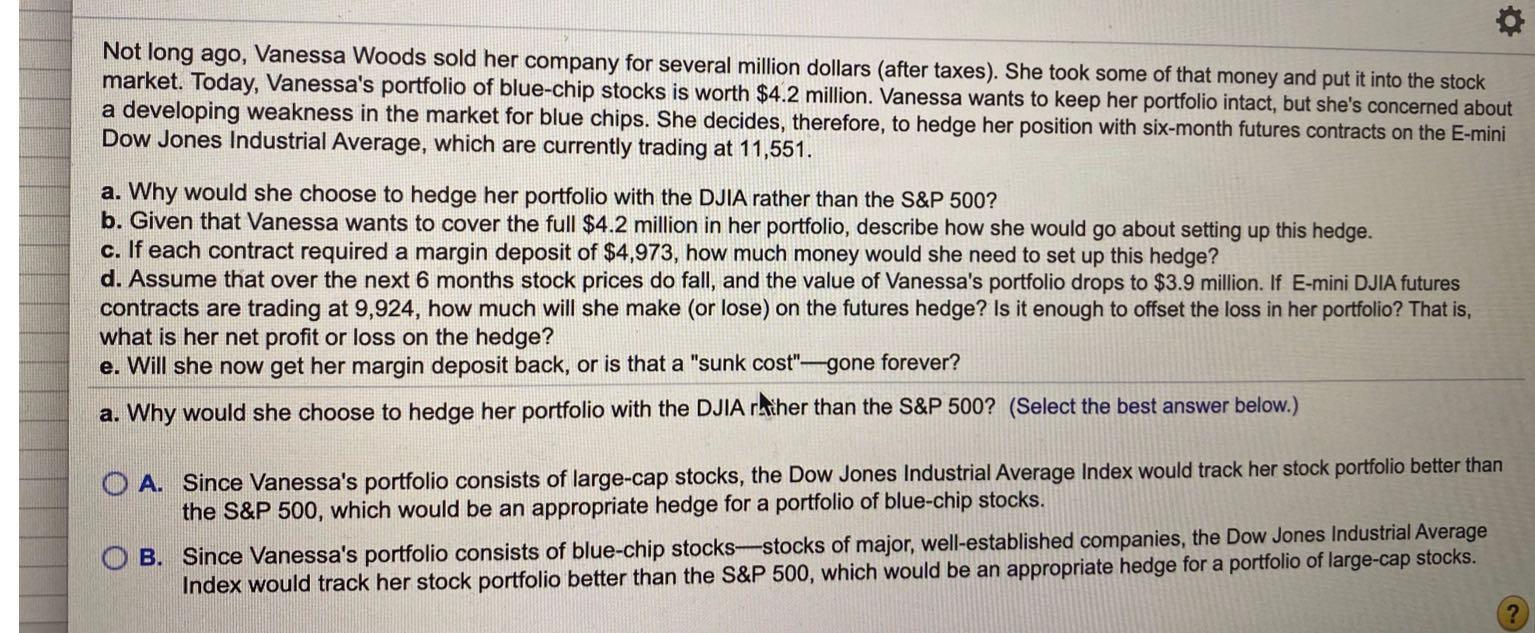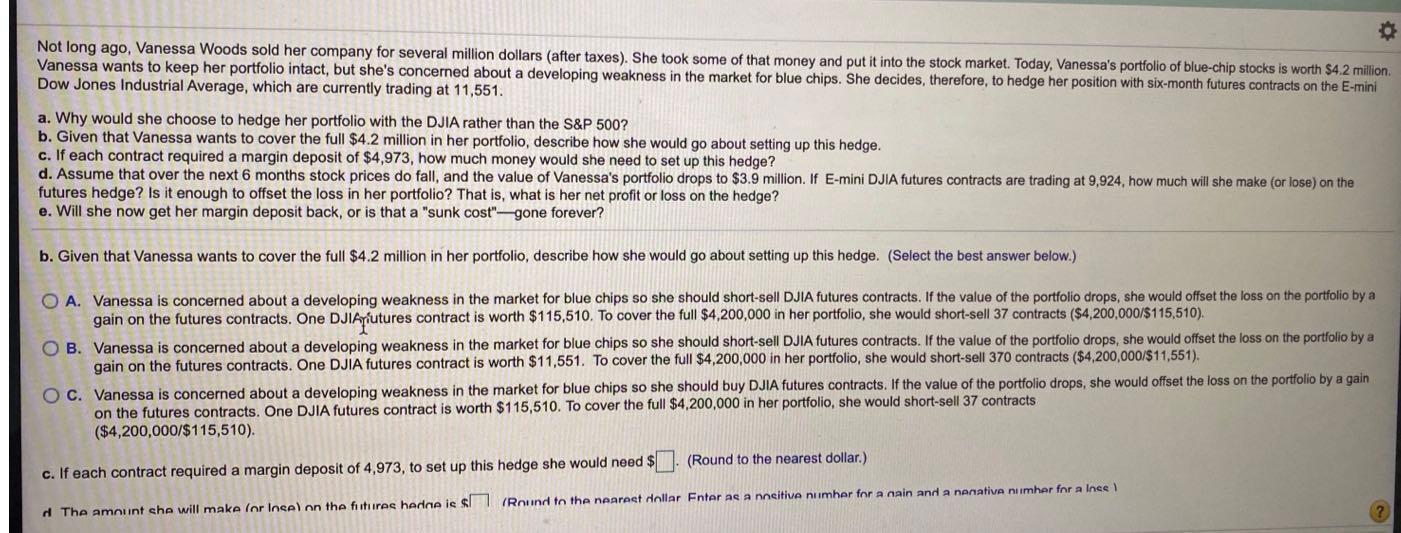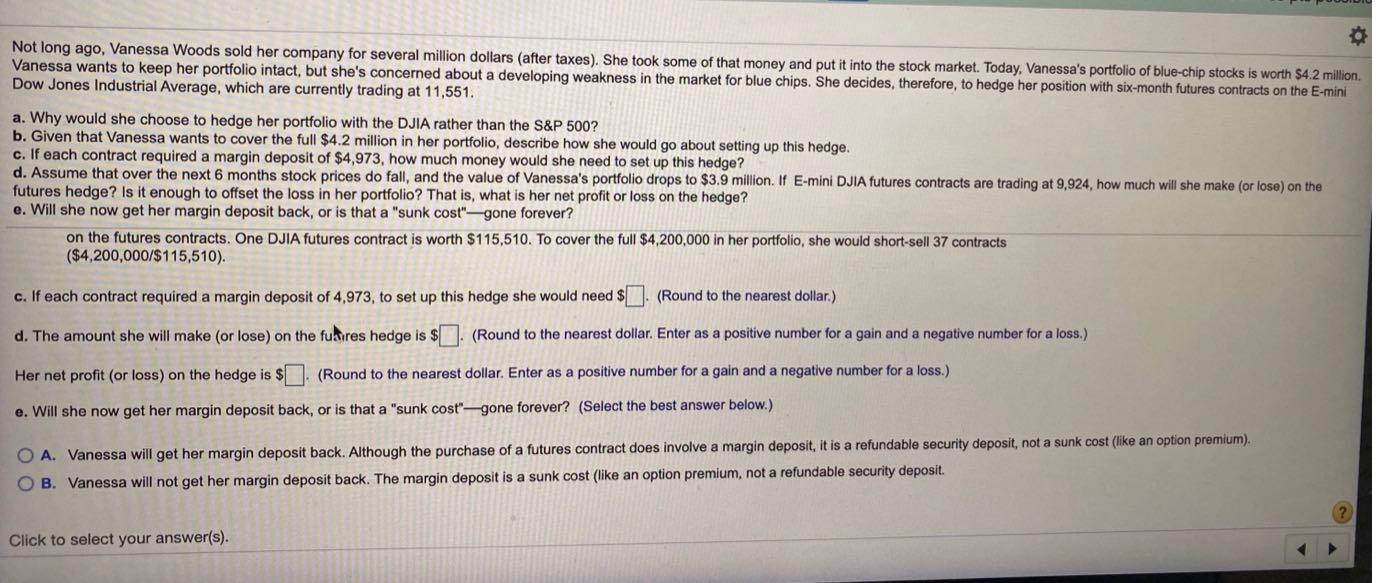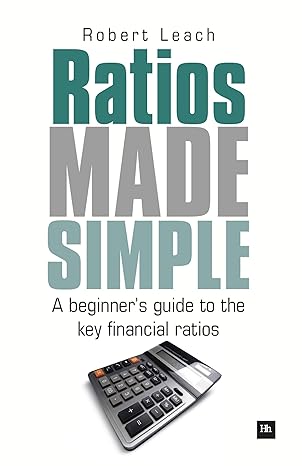


Not long ago, Vanessa Woods sold her company for several million dollars (after taxes). She took some of that money and put it into the stock market. Today, Vanessa's portfolio of blue-chip stocks is worth $4.2 million. Vanessa wants to keep her portfolio intact, but she's concerned about a developing weakness in the market for blue chips. She decides, therefore, to hedge her position with six-month futures contracts on the E-mini Dow Jones Industrial Average, which are currently trading at 11,551. a. Why would she choose to hedge her portfolio with the DJIA rather than the S&P 500? b. Given that Vanessa wants to cover the full $4.2 million in her portfolio, describe how she would go about setting up this hedge. c. If each contract required a margin deposit of $4,973, how much money would she need to set up this hedge? d. Assume that over the next 6 months stock prices do fall , and the value of Vanessa's portfolio drops to $3.9 million. If E-mini DJIA futures contracts are trading at 9,924, how much will she make (or lose) on the futures hedge? Is it enough to offset the loss in her portfolio? That is, what is her net profit or loss on the hedge? e. Will she now get her margin deposit back, or is that a "sunk cost"-gone forever? a. Why would she choose to hedge her portfolio with the DJIA rather than the S&P 500? (Select the best answer below.) O A. Since Vanessa's portfolio consists of large-cap stocks, the Dow Jones Industrial Average Index would track her stock portfolio better than the S&P 500, which would be an appropriate hedge for a portfolio of blue-chip stocks. O B. Since Vanessa's portfolio consists of blue-chip stocks-stocks of major, well-established companies, the Dow Jones Industrial Average Index would track her stock portfolio better than the S&P 500, which would be an appropriate hedge for a portfolio of large-cap stocks. ? o Not long ago, Vanessa Woods sold her company for several million dollars (after taxes). She took some of that money and put it into the stock market. Today, Vanessa's portfolio of blue-chip stocks is worth $4.2 million Vanessa wants to keep her portfolio intact, but she's concerned about a developing weakness in the market for blue chips. She decides, therefore, to hedge her position with six-month futures contracts on the E-mini Dow Jones Industrial Average, which are currently trading at 11,551. a. Why would she choose to hedge her portfolio with the DJIA rather than the S&P 500? b. Given that Vanessa wants to cover the full $4.2 million in her portfolio, describe how she would go about setting up this hedge. c. If each contract required a margin deposit of $4,973, how much money would she need set up this hedge? d. Assume that over the next 6 months stock prices do fall, and the value of Vanessa's portfolio drops to $3.9 million. If E-mini DJIA futures contracts are trading at 9,924, how much will she make (or lose) on the futures hedge? Is it enough to offset the loss in her portfolio? That is, what is her net profit or loss on the hedge? e. Will she now get her margin deposit back, or is that a "sunk cost"gone forever? b. Given that Vanessa wants to cover the full $4.2 million in her portfolio, describe how she would go about setting up this hedge. (Select the best answer below.) O A. Vanessa is concerned about a developing weakness in the market for blue chips so she should short-sell DJIA futures contracts. If the value of the portfolio drops, she would offset the loss on the portfolio by a gain on the futures contracts. One DJIAputures contract is worth $115,510. To cover the full $4,200,000 in her portfolio, she would short-sell 37 contracts ($4,200,000/$115,510). OB. Vanessa is concerned about a developing weakness in the market for blue chips so she should short-sell DJIA futures contracts. If the value of the portfolio drops, she would offset the loss on the portfolio by a gain on the futures contracts. One DJIA futures contract is worth $11,551. To cover the full $4,200,000 in her portfolio, she would short-sell 370 contracts ($4,200,000/$11,551). O C. Vanessa is concerned about a developing weakness in the market for blue chips so she should buy DJIA futures contracts. If the value of the portfolio drops, she would offset the loss on the portfolio by a gain on the futures contracts. One DJIA futures contract is worth $115,510. To cover the full $4,200,000 in her portfolio, she would short-sell 37 contracts ($4,200,000/$115,510). c. If each contract required a margin deposit of 4,973, to set up this hedge she would eed $ ). (Round to the nearest dollar.) d The amount she will make (or Insel on the futures hedge is s (Round to the nearest dollar Enter as a positive number for a nain and a nenative number for a Ince! Not long ago, Vanessa Woods sold her company for several million dollars (after taxes). She took some of that money and put it into the stock market. Today, Vanessa's portfolio of blue-chip stocks is worth $4.2 million Vanessa wants to keep her portfolio intact, but she's concerned about a developing weakness in the market for blue chips. She decides, therefore, to hedge her position with six-month futures contracts on the E-mini Dow Jones Industrial Average, which are currently trading at 11,551. a. Why would she choose to hedge her portfolio with the DJIA rather than the S&P 500? b. Given that Vanessa wants to cover the full $4.2 million in her portfolio, describe how she would go about setting up this hedge. c. If each contract required a margin deposit of $4,973, how much money would she need to set up this hedge? d. Assume that over the next 6 months stock prices do fall, and the value of Vanessa's portfolio drops to $3.9 million. If E-mini DJIA futures contracts are trading at 9,924, how much will she make (or lose) on the futures hedge? Is it enough to offset the loss in her portfolio? That is, what is her net profit or loss on the hedge? e. Will she now get her margin deposit back, or is that a "sunk cost"-gone forever? on the futures contracts. One DJIA futures contract is worth $115,510. To cover the full $4,200,000 in her portfolio, she would short-sell 37 contracts ($4,200,000/$115,510). c. If each contract required a margin deposit of 4,973, to set up this hedge she would need $ (Round to the nearest dollar.) d. The amount she will make (or lose) on the fuaires hedge is $ (Round to the nearest dollar. Enter as a positive number for a gain and a negative number for a loss.) Her net profit (or loss) on the hedge is $(. (Round to the nearest dollar. Enter as a positive number for a gain and a negative number for a loss.) e. Will she now get her margin deposit back, or is that a "sunk cost"-gone forever? (Select the best answer below.) A. Vanessa will get her margin deposit back. Although the purchase of a futures contract does involve a margin deposit, it is a refundable security deposit, not a sunk cost like an option premium). OB. Vanessa will not get her margin deposit back. The margin deposit is a sunk cost (like an option premium, not a refundable security deposit Click to select your answer(s)









